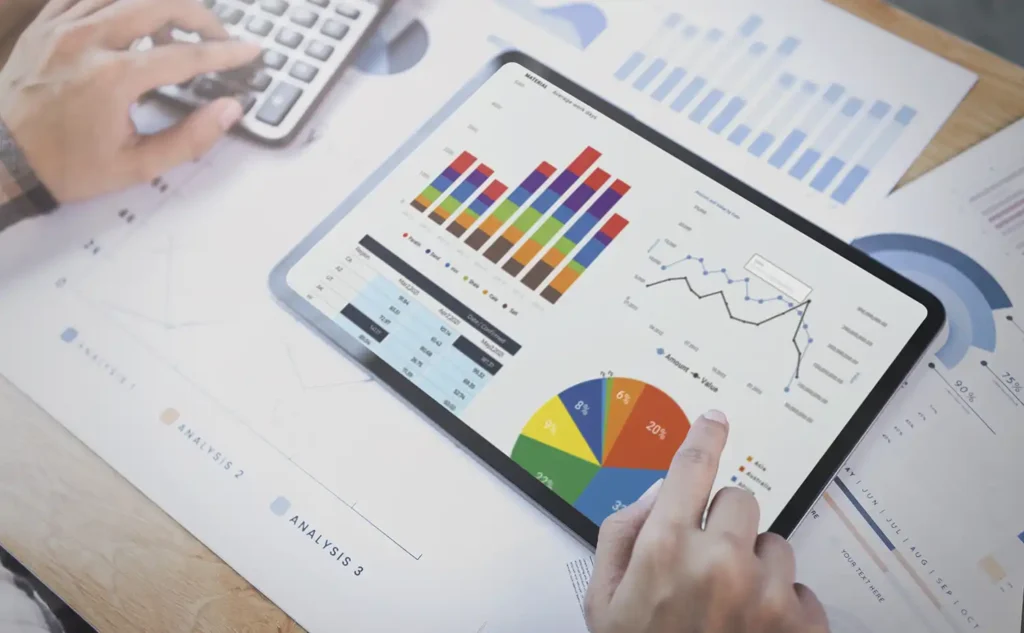2023 was a year of dynamic stream of innovation, reshaping the way organizations leverage analytics and business intelligence (BI). In part one of “The 2023 Evolution of Data, Analytics and AI“ series, we covered popular data-driven trends shaping the digital landscape. In the same way, part two delved into in-depth data management key trends and transformations in 2023.
Now, we shift to the evolution of business intelligence (BI) and analytics. Following part three, where we cover the business intelligence (BI) evolution and analytics, presenting the latest advancements this year and navigating through current trends!


The world of business intelligence and analytics has undergone a quantum leap in 2023 and recent years. Several forces fuel this transformation: technological leaps and data abundance, coupled with a growing emphasis on data-driven decision-making. Several shifts characterize this evolution, including:
Self-Service BI and Analytics: Catalysts for Business Efficiency
In business intelligence, timely insights are paramount for informed decisions across project lifecycles. Companies prioritize empowering employees with data querying skills, therefore reflecting the industry’s emphasis on data literacy and trends like interactivity and augmented analytics for autonomy.
Self-service analytics enables end-users to independently analyze data and generate reports. With interactive dashboards and user-friendly interfaces, it fosters a data-driven decision culture. However, its adoption necessitates basic data skills, and organizations must establish robust data governance for security, privacy, and quality.
As technological proficiency continues to grow, the demand for independent data access has risen. Centralized data and self-service BI are becoming global standards, enabling users to address challenges promptly. As a result, this shift improves decision-making with a unified truth. A self-service data model promotes a data-driven culture, fostering user self-sufficiency and reducing dependence on IT. The future of business intelligence lies in integrating self-service tools, boosting data literacy, and committing to a data-first culture, allowing users to meet analytical needs and make critical decisions more efficiently.
Augmented Analytics
In 2023, artificial intelligence and machine learning continued to drive the ongoing revolution in business intelligence through augmented analytics. Augmented analytics simplifies data processes, enhances insight creation, and facilitates seamless sharing, democratizing BI access. Acting as a catalyst, it empowers users and executives to navigate platforms effortlessly. Furthermore, through intuitive interactions, machine learning and AI enable swift discovery of valuable insights, transforming BI into a user-friendly experience.
Augmented analytics distinguishes itself through automation and accessibility, departing from traditional methods reliant on manual processes and specialized skills. Consequently, by automating these tasks, it speeds up data analysis, boosting efficiency and negating the need for technical expertise.
This trend marks a new era, democratizing data understanding and utilization, irrespective of one’s data science background. Augmented analytics promotes a more inclusive and agile business intelligence paradigm without a doubt.
Data Storytelling
The year 2023 marks a pivotal point in the evolution of data storytelling. In today’s data-driven business landscape, storytelling goes beyond traditional data structuring and visualization. Moreover, a narrative layer is now recognized as essential, adding context and interpretation to raw numbers.
Effective data analysis is more than just numbers; it’s about crafting a meaningful story to guide decisions in a complex and dynamic environment.
Data storytelling blends visualization, narrative, and human-centered design, thus surpassing traditional data interpretation. This enhances information accessibility and communicates the significance of insights, rendering data relatable and applicable in decision-making; a sophisticated fusion guiding strategic choices.
The shift from traditional dashboards to data stories signifies a crucial shift in how businesses engage with information. As we embrace storytelling, raw data becomes a cohesive narrative, deepening statistical understanding. As a result, this empowers action on insights, underscoring the need for a contextualized data view in an unbiased, decision-driven landscape. In business intelligence, data storytelling simplifies complex market dynamics, as well as customer behaviors, translating insights into strategies for informed decision-making.
Natural Language Processing (NLP)
In the business analytics landscape, AI and ML are catalysts for a significant transformation, with Natural Language Processing (NLP) emerging as a key player. NLP revolutionizes communication with computers, extending its impact beyond translation to platforms like Google Voice and Google Translate. However, NLP’s true potential shines in business analytics, where it serves as a linchpin for transformative change.
Gartner forecasts that by 2024, 75% of companies will adopt NLP-based solutions, underlining its pivotal role in business development and information management transformation.
In 2023, the integration of ‘explainable intelligence’ marked a significant leap in this field. Due to clarifying decision-making, it adds transparency and comprehension to the process. The convergence of AI, ML, and explainable intelligence is reshaping business analytics, propelling organizations to the forefront of technological innovation. This technological convergence signifies a paradigm shift, highlighting the importance of transparent decision-making in business analytics.
Cloud-based BI
The business intelligence (BI) landscape underwent a transformative shift in the widespread adoption of cloud platforms. As businesses prioritized migration to cloud-based BI and analytics platforms due to the challenges faced by on-premise solutions in supporting remote work, Gartner’s report highlighted that 40% of enterprise workloads now deploy in the cloud.
Organizations now increasingly opt for cloud-based business intelligence solutions for enhanced efficiency and actionable insights. In addition, these platforms provide scalability, flexibility, and real-time access to crucial business data, setting them apart from pricier on-premise options.
Cloud BI’s scalability caters to changing data volumes, thus enabling adaptive storage and processing. As databases transition to the cloud, new BI solutions emerged, emphasizing real-time data access for informed decision-making. Forbes reports that 75% of executives acknowledge the significance of real-time data in enhancing decision-making capabilities.
Undoubtedly, cloud-based business intelligence (BI) is key for collaborative productivity. Choosing between public, private, or hybrid deployment is crucial for cost-effective, secure, and compliant solutions. Integrating cloud BI ensures enduring competitiveness and resilience in dynamic business landscapes.
Advanced data governance and security
In business intelligence, organizations prioritize specialized data roles, with a focus on data stewards. This, coupled with the demand for BI software featuring role-based permissions, reflects the commitment to data security. Implementing a governance framework aligned with industry standards is crucial for ensuring strict oversight, penalties adherence, and robust data security.
Data quality management is a key BI trend, with the global data governance market projected to reach $11.68 billion by 2030. Ethical considerations reshape trends, focusing on policies, procedures, and structures for quality, security, and ethical dimensions in data collection, processing, and utilization.
Moreover, ethical data governance safeguards privacy through practices like informed consent, anonymization, and strict access controls. Not only does it prevent biases and harm in data usage, but also reduces reputational risks. Ethical practices are essential for trust and compliance with regulations like GDPR and HIPAA.


In Conclusion
Part three of “The 2023 Evolution of Data, Analytics and AI” series covered the transformative trends driving the evolution of business intelligence (BI) and analytics. These domains in 2023 reflect a dynamic evolution, driven by technological leaps, data abundance, and an unwavering focus on data-driven decision-making.
Stay tuned for part four of the series – AI Advancements in 2023 – Emerging Trends and Future Directions! Part four immerses into the 2023 AI advancements and emerging trends and future directions at the forefront of artificial intelligence.
Check out the first part that covers six popular data-driven trends that have steered the digital landscape in 2023. It showcases the forces that shape the digital realm, from cutting-edge technology integration to the influence of global events. Moreover, check out part 2 – covering data management, highlighting key trends and transformations that have gained significant momentum in 2023, surpassing the developments of the preceding years.
For the newest insights in the world of data and AI, subscribe to Hyperight Premium. Stay ahead of the curve with exclusive content that will deepen your understanding of the evolving data landscape.















Add comment